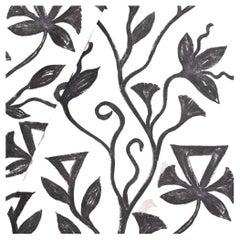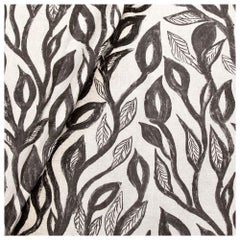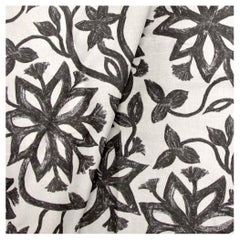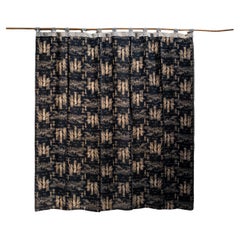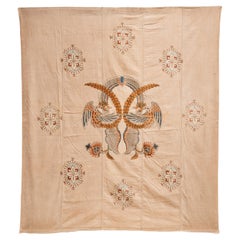L'Aviva Home Textiles
to
3
3
3
3
3
3
3
3
3
197
30
11
10
9
Creator: L'Aviva Home
Oatmeal Linen, Khovar Collection, Vine (Fabric by the yard)
By L'Aviva Home
Located in New York, NY
This collection takes its lead from the tribal villages of Hazaribagh in Northeastern India, where the walls of the villages’ mud homes are decorated with rambling, figurative murals...
Category
21st Century and Contemporary Indian Anglo-Indian L'Aviva Home Textiles
Materials
Linen
Oatmeal Linen, Khovar Collection, Leaf (Fabric by the yard)
By L'Aviva Home
Located in New York, NY
This collection takes its lead from the tribal villages of Hazaribagh in Northeastern India, where the walls of the villages’ mud homes are decorated with rambling, figurative murals...
Category
21st Century and Contemporary Indian Anglo-Indian L'Aviva Home Textiles
Materials
Linen
Oatmeal Linen, Khovar Collection, Flower (Fabric by the yard)
By L'Aviva Home
Located in New York, NY
This collection takes its lead from the tribal villages of Hazaribagh in Northeastern India, where the walls of the villages’ mud homes are decorated with rambling, figurative murals...
Category
21st Century and Contemporary Indian Anglo-Indian L'Aviva Home Textiles
Materials
Linen
Related Items
Japanese Vintage Linen Noren, Textile, Wabi Sabi, 19th Century
Located in Tokyo, Tokyo
The unique and beautiful fabric piece, that's called noren - traditional Japanese fabric divider that was made during the Meiji era. This traditional Japanese curtains used to divide...
Category
19th Century Japanese Antique L'Aviva Home Textiles
Materials
Linen
Japanese Vintage Fabric, Wabi Sabi, 1910s
Located in Tokyo, Tokyo
This unique and elegant textile with a phoenix pattern, known as Nagasaki Sarasa, was made in Nagasaki Prefecture (Kyushu) during the Taisho era.
The fabric was likely intended fo...
Category
1910s Japanese Vintage L'Aviva Home Textiles
Materials
Cotton
HOLLYHOCKS Cotton Linen - Spring
By House of Hackney
Located in New York, NY
Reminiscent of the lush colour and luminous cheerfulness found in Gustav Klimt's paintings of flower gardens, HOLLYHOCKS was created especially for House of Hackney by American artist Kerry Simmons, based on her own work of the same name. While capturing the pastoral purity and romance of cottagecore, our punk spirit is embedded in its bold palette and riot of flowers. Printed in Britain, this smooth cotton-linen will make for enlivening window coverings...
Category
21st Century and Contemporary British L'Aviva Home Textiles
Materials
Linen
Franciscan Fabrics San Francisco Hand Block Print Textile Fabric 1970s
Located in North Hollywood, CA
Franciscan Fabrics Linen Collectable 1970-1979 Time Period Manufactured Interiors Fabric.
Franciscan Fabrics San Francisco hand block print upholstery fabric.
Such a beautiful rich &...
Category
Late 20th Century American Mid-Century Modern L'Aviva Home Textiles
Materials
Textile
Indian Embroidery Fabric, N°1221
Located in Paris, FR
Indian embroidery fabric - N°1221
Thanks to our Restoration-Conservation workshop and also Our know-how,
we are pleased to present to you works ...
Category
1960s Indian Tribal Vintage L'Aviva Home Textiles
Materials
Wool
Modern Polished Cotton Fabric With Tropical Flamingo Design, 9 Yards Total
Located in Van Nuys, CA
This beautiful silky polished cotton fabric is made by Argentea from the design studios of David and Dash Inc. by Amin Khalaf and treated with Scotchgard fabric protector. It feature...
Category
1970s American Modern Vintage L'Aviva Home Textiles
Materials
Cotton
$957 Sale Price
40% Off
H 1 in W 54 in D 36 in
Japanese Woven Linen Kimono with Katazome Stencil Dyes
Located in Atlanta, GA
On offer is a Japanese summer kimono woven from indigo blue linen with ivory color fine stripes patterns with apparently darker weft additions. The elega...
Category
Early 20th Century Japanese Japonisme L'Aviva Home Textiles
Materials
Linen
Linen and Cotton Antique Panel from Toraja Land
Located in New York, NY
Striking ‘pelangi’ tie-dyed textile from Toraja Land, South Sulawesi. We added a linen border, double backed on both ends. This beautiful panel can be used as a wall hanging, draped ...
Category
Mid-20th Century Indonesian Tribal L'Aviva Home Textiles
Materials
Cotton, Linen
Vintage Moroccan Kaftan in Turquoise Cheer Fabric
By Berber Tribes of Morocco
Located in North Hollywood, CA
Elegant Moroccan caftan in turquoise cheer fabric and hand braided embroidered trim,
circa 1970s.
This long maxi dress kaftan is embellished entirely by hand.
It’s crafted in Morocco...
Category
20th Century Moroccan L'Aviva Home Textiles
Materials
Fabric
African Batik Cloth Natural Hand-woven Hand-Printed Cotton Fabric Ghana 10 Yards
Located in North Hollywood, CA
African Batik Cloth Natural Hand-woven Hand-Printed Cotton Fabric Ghana 10 yards.
Colors are organic earth tone beige and light brown in geometric design.
Non waxed fabric circa 1950s.
Hand made in Ghana Africa.
Museum Quality Original Long Piece.
380 inches, (30 ft 10 yards Long) x 46 inches Inches Wide( 4ft).
Could be use to make pillows or upholstery.
History of Batik in Africa:
Batik, a traditional fabric art technique, has a rich history in Ghana, West Africa. The practice of batik involves using wax to create intricate patterns on fabric, which is then dyed to achieve the desired design. While batik has its origins in Asia, particularly in Indonesia, it has been embraced and adapted by various African countries, including Ghana.
In Ghana, batik-making can be traced back to the mid-20th century when it gained popularity as a form of traditional textile art. The craft was introduced by artists and artisans who were inspired by the vibrant and expressive nature of batik. These early practitioners experimented with different designs, colors, and patterns, infusing local themes and motifs into their creations.
Over time, batik became an important part of Ghanaian culture and identity. It is not only used for clothing but also for various decorative and functional items such as wall hangings, tablecloths, and accessories. The art form often reflects the rich cultural heritage of Ghana, incorporating symbols, proverbs, and traditional stories into the designs.
Ghanaian batik artists often employ a combination of traditional and contemporary elements, creating a unique fusion of styles. The process of making batik involves applying hot wax to the fabric using various tools to create the desired patterns. The wax acts as a resist, preventing dye from penetrating the waxed areas. After dyeing, the wax is removed, revealing the intricate designs on the fabric.
Today, batik-making in Ghana continues to thrive as both a traditional craft and a form of artistic expression. Many artisans and designers draw inspiration from Ghana's diverse cultural landscape, incorporating elements from different regions and ethnic groups into their batik creations. The art form has also gained international recognition, with Ghanaian batik products being sought after both locally and abroad.
In summary, the history of batik in Ghana is a testament to the creativity and adaptability of artists who have embraced and transformed this traditional technique into a vibrant and culturally significant art form within the country.
HISTORY OF BATIK
In the mid-nineteenth century, the Belanda Hitam, or "Black Dutchmen," are said to have introduced batik to West Africa after serving as indentured soldiers for the Dutch in Indonesia. Returning from their conscriptions with trunks of fine Javanese batik, the opulent patterns captured the imagination of their friends and relatives. However, textile history is complex, and only a handful of recruits returned to West Africa with batik due to delayed payments.
Batik, with roots traced to Egyptian mummies, is a tradition found globally, from Southeast Asia to Japan and India. Europeans, particularly the Dutch, played a significant role in industrializing batik from the seventeenth century onward.
In West Africa, Dutch Scholar Ineke van Kessel suggests that batik arrived from India over trans-Saharan routes. Local populations, like the Yoruba in Nigeria, incorporated wax printing into their textiles. European traders brought wax and non-wax fabrics to West Africa in the seventeenth century, targeting a population ready for their consumption. European designers adapted prints for the African market...
Category
Mid-20th Century Ghanaian Folk Art L'Aviva Home Textiles
Materials
Cotton
$1,450
H 360 in W 45.5 in D 0.05 in
PLANTASIA Cotton Linen - Sage
By House of Hackney
Located in New York, NY
Bring the magic of the forest into your home with PLANTASIA. Painted with mighty and majestic trees stretching out as far as the horizon, PLANTASIA is our vision of an idyllic landsc...
Category
21st Century and Contemporary British L'Aviva Home Textiles
Materials
Linen
Ripple Fabric in Silver and Indigo, Belgian Linen (Fabric by the Yard)
By ROUSSEAU
Located in New York, NY
Ripple is our love letter to indigo dye, detailed shapes ripple beautifully throughout the bold pattern, seen here in Silver. Pigment printed on 100% Belgian Linen. Designed in New Y...
Category
2010s American Modern L'Aviva Home Textiles
Materials
Linen
$210 / item
H 36 in W 54 in D 0.05 in
L'aviva Home textiles for sale on 1stDibs.
L'Aviva Home textiles are available for sale on 1stDibs. These distinctive items are frequently made of linen and are designed with extraordinary care. There are many options to choose from in our collection of L'Aviva Home textiles, although gray editions of this piece are particularly popular. Prices for L'Aviva Home textiles can differ depending upon size, time period and other attributes — on 1stDibs, these items begin at $150 and can go as high as $150, while a piece like these, on average, fetch $150.
